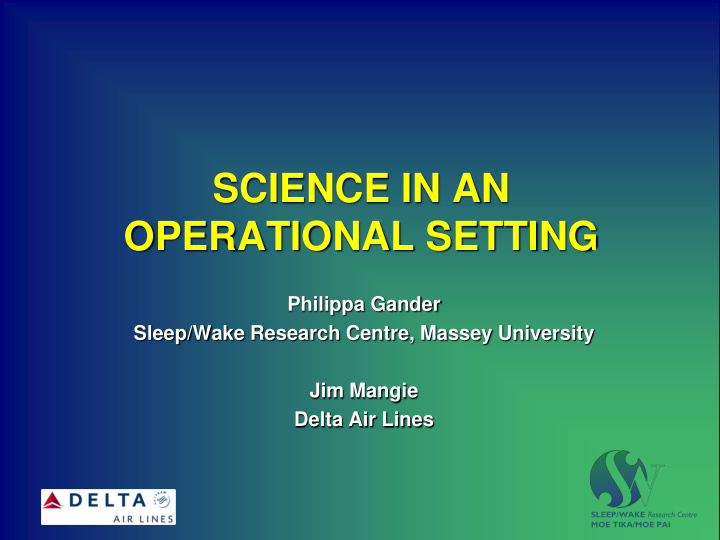



SCIENCE IN AN OPERATIONAL SETTING Philippa Gander Sleep/Wake Research Centre, Massey University Jim Mangie Delta Air Lines SLEEP/WAKE Research Centre MOE TIKA/MOE PAI
Outline • What to measure • When to measure • Interpreting the data • Safety Performance Indicators • Conclusions SLEEP/WAKE Research Centre MOE TIKA/MOE PAI
What to Measure: Crew Fatigue ICAO definition of fatigue: A physiological state of reduced mental or physical performance capability resulting from sleep loss or extended wakefulness, circadian phase, or workload (mental and/or physical activity) that can impair a crew member’s alertness and ability to safely operate an aircraft or perform safety related duties. Functional status (subjective ,objective) Sleep history Circadian phase Workload SLEEP/WAKE Research Centre MOE TIKA/MOE PAI
Sleep: Actigraphy and Diaries SLEEP/WAKE Research Centre MOE TIKA/MOE PAI
When to Measure Crew Fatigue • Monitoring for FRM Processes • In response to a series of fatigue reports • to identify extent and severity of hazard • In response to an incident • SPIs to evaluate effectiveness of fatigue mitigations and controls • Validation of a new route • Monitoring for FRMS Assurance Processes • SPIs set in FRMS Policy objectives • SPIs for regulatory audit Crew fatigue measures may not always be needed SLEEP/WAKE Research Centre MOE TIKA/MOE PAI
Safety Performance Indicators (SPIs) 5 FRMS Components 3. Risk Management Processes 1. Policy Fatigue 4.Safety Assurance SMS Safety Processes Action Group 5. Promotion 2. Documentation Processes SLEEP/WAKE Research Centre MOE TIKA/MOE PAI
Safety Performance Indicators: Example Comparing fatigue on ULR and LR flights SLEEP/WAKE Research Centre MOE TIKA/MOE PAI
Fatigue Status at Start of Duty SPI – sleep in the last 24 hrs 12 10 8 Median sleep 6 (hrs) 24 hrs prior to duty Landing 4 Relief 2 0 SLEEP/WAKE Research Centre MOE TIKA/MOE PAI
Fatigue Status at Start of Duty SPI – mean PVT reaction speed early in flight 5 4.5 4 mean PVT 3.5 reaction speed Landing 3 Relief 2.5 2 SLEEP/WAKE Research Centre MOE TIKA/MOE PAI
Fatigue Status at Top of Descent SPI – median total in-flight sleep 4.5 4 3.5 3 2.5 Median sleep in flight (hrs) 2 Landing 1.5 Relief 1 0.5 0 SLEEP/WAKE Research Centre MOE TIKA/MOE PAI
Fatigue Status at Top of Descent SPI – mean PVT reaction speed late in flight 5 4.5 4 mean PVT 3.5 reaction speed Landing 3 Relief 2.5 2 SLEEP/WAKE Research Centre MOE TIKA/MOE PAI
Fatigue Status at Top of Descent SPI – % crew with KSS ≥ 7 50 45 40 35 30 % 25 crewmembers 20 Landing 15 Relief 10 5 0 SLEEP/WAKE Research Centre MOE TIKA/MOE PAI
Operational SPIs: Examples • Track data on number of : • exceedances of planned crew duty day (e.g. > 14 hrs) • flight duty periods ending > 30 mins later than scheduled • flight duty periods starting / ending within window of circadian low (WOCL) • reserve crew call-outs (on particular flights, at a particular crew base, etc) Monitoring of FRM processes Monitoring of FRMS safety assurance processes SLEEP/WAKE Research Centre MOE TIKA/MOE PAI
Conclusions • Challenge • Developing in-house expertise versus using consultants ($$) • Data sharing • Operators don’t have to reinvent the wheel • Rich data source for improving fatigue science • Needs • Paradigms for data sharing • Better indicators of fatigue-related performance impairment • Better fatigue measurement technologies • Better fatigue risk assessment (safety consequences of being fatigued in a given context) • Better fatigue risk controls and mitigations Cooperation is the key SLEEP/WAKE Research Centre MOE TIKA/MOE PAI
Acknowledgements • Dr Jarnail Singh, CAA of Singapore • Participants in B-777 study • Delta data collection team • Scientific Steering Committee, FAA 3-airline study • Margo van den Berg, Dr Leigh Signal, Dr Sarah Jay, Sleep/Wake Research Centre SLEEP/WAKE Research Centre MOE TIKA/MOE PAI
Recommend
More recommend